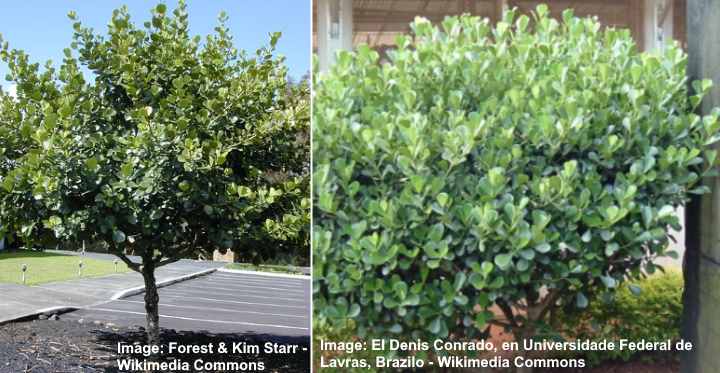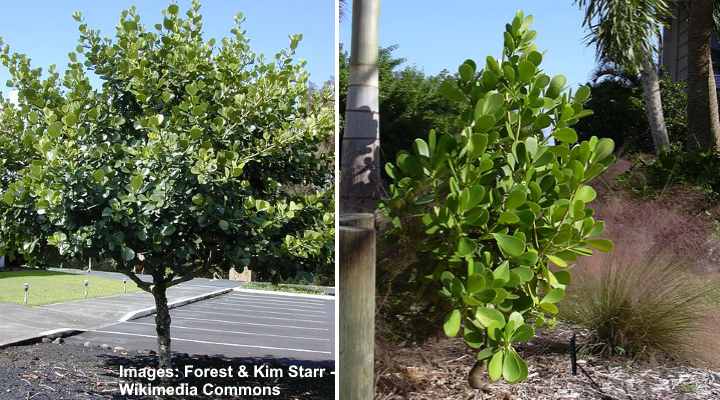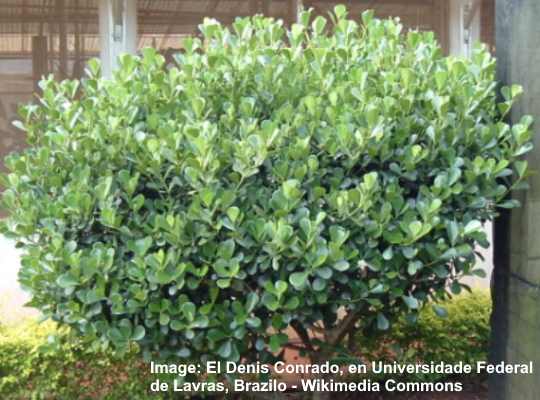Clusia Plant: How to Care for Clusia Hedge (Clusia Rosea & Clusia Guttifera)

Clusia (Clusia guttifera) is an evergreen shrub that makes an excellent hedge or privacy screen. Clusia is a popular hedge shrub because of its dense foliage that is made up of evergreen oval, teardrop-shaped leaves. This shrub is resistant to drought, hot sun, and salt. It is also an ideal privacy screen because of its low maintenance and fast growing nature.
How to care for Clusia hedge: Clusia guttifera thrives in full sun in warm climates. For a healthy hedgerow, water the shrub regularly, and make sure the fertile soil has excellent drainage. Grow Clusia hedges in zones 10 and 11, where the temperature doesn’t fall below 30°F (-1°C).
The thick paddle-shaped leaves on Clusia shrubs create a dense informal look. Clusia hedges can grow tall, but regular trimming of the shrubs keeps the informal hedge to between 5 and 6 ft. (1.5 – 1.8 m) tall. Clusia shrubs are perfect privacy hedges for shelter from the wind, noise, and prying neighbors.
Another Clusia variety is Clusia rosea which is a large tree that has leaves similar to the Clusia bush.
Clusia rosea ‘Nana’ is a dwarf variety of the Clusia tree that doesn’t reach more than 3 ft. (1 m) tall. When planted close together, the dwarf Clusia rosea can create a lush, bushy hedgerow that ensures privacy and year-long foliage in your backyard.
This article is a complete care guide for growing Clusia hedges.
Clusia Tree (Clusia rosea)

Clusia tree (clusia rosea) in the left picture and dwarf clusia tree (Clusia rosea ‘Nana’) in the right
Clusia rosea is a popular medium-sized flowering tree native to tropical America. Also called the autograph tree or pitch apple, Clusia trees grow up to 65 ft. (20 m) tall. Their evergreen foliage comprises of thick olive-green, oval-shaped leaves. Dwarf varieties of Clusia trees are ideal hedges.
Clusia Hedge (Clusia guttifera)

Clusia shrub (Clusia guttifera)
Clusia guttifera (small leaf Clusia) is a popular hedge plant in tropical countries. Clusia shrubs grow as a natural evergreen living fence with low branches reaching heights of 25 ft. (7.5 m) tall. Regular trimming keeps the Clusia dense hedge to a more manageable height of 5 ft. (1.2 m).
Clusia hedges are also a superb landscaping plant. Apart from growing as a glossy-green hedge, the small leaf Clusia is suitable for planting around a patio, along a fence, as a natural privacy screen, or as a specimen plant. Clusia shrubs and trees also grow well in containers.
How to Care for Clusia Hedge
Let’s look in more detail at how to care for Clusia hedgerows so that they produce healthy glossy foliage all year long.
Light Requirements for Growing Clusia Guttifera Hedges
Small leaf Clusia shrubs are plants for full sun. Grow Clusia hedges in your garden where they get sun exposure for six to eight hours. Regularly water Clusia plants to keep them thriving in the heat and full sun. Clusia also grows in partial shade.
The Best Soil for Planting Clusia Hedges
Grow Clusia plants in fertile soil that has excellent drainage. Clusia hedges are attractive, low-maintenance shrubs that also perform well in most soil types. Although fertile soil is best for Clusia, they also grow well in poor soil conditions in coastal areas.
When planting Clusia shrubs for a hedgerow, it’s best to ensure that the fertile ground is well-draining. It may be necessary to work in coarse horticultural sand or perlite to improve drainage. Also, plenty of organic matter doesn’t just enhance the soil’s nutrient profile, but also helps to retain essential moisture.
Clusia hedges are ideal for growing in locations where the soil isn’t ideal. The Clusia’s thick, leathery foliage is relatively salt-tolerant, and most species of Clusia plants thrive near the coast.
Clusia Hedges Watering Needs
Small leaf Clusia grows best with regular watering. Although Clusia hedges are drought-tolerant, regular irrigation helps keep the roots hydrated. During the first year after planting, water the shrubs regularly—allowing the soil to partially dry out between watering. Once established, water Clusia when there are dry spells.
In general, Clusia hedges—like most types of hedges—need to be well-watered. After dry periods thoroughly water the hedgerow roots. You should provide enough water so that it sinks deep into the soil. Although Clusia hedge plants tolerate drought, they thrive when they get enough moisture.
Watering Clusia hedges is especially crucial in the first year after planting. You should provide approximately 5 quarts (5 l) of water for every 3 feet (1 m) of hedging. Water at least twice a week until the Clusia hedge plants are established. Remember, in hot weather, it’s vital to water the hedge plants more often.
Temperature & Humidity
Clusia hedges grow in USDA zones 10 and 11. This means that the minimum outdoor temperature for Clusia plants is between 30°F and 40°F (-1°C to +4°C). But the best minimum temperature for Clusia hedges is 50°F (10°C) — which is about the average temperature for Miami in winter.
Clusia plants enjoy high humidity of over 50%. So, growing outdoors in warm tropical regions isn’t a problem for these easy-care evergreen perennial hedges.
For people who keep autograph trees (Clusia rosea) as an indoor plant, average room temperatures are ideal. To increase humidity and moisture, mist the leaves regularly and only water the plant when the soil partly dries.
How to Plant Clusia Hedge
To plant a Clusia guttifera hedge, you should start off with small healthy plant shrubs. Make sure and have enough plants for the length of your evergreen hedgerow—shrub stems should be at least 5 feet (1.2 m) apart. Before planting Clusia, you’ll need to prepare the soil so that it’s fertile and well-draining.
To grow a formal hedge, plant the shrubs about 5 feet (1.2 m) apart. However, if you want a less formal natural fence, you could space the plants further apart. Leaving enough space between shrub stems gives foliage enough room to breathe and flourish.
The best time to plant a new Clusia hedge is in the spring, just before the growing season.
How to plant the Clusia hedge:
- Dig holes at least 5 feet apart along the line of the new Clusia hedge.
- The holes should be as deep as the Clusia root ball and three times as wide.
- Carefully ease the Clusia plant from its container.
- Place the Clusia plant in the hole and fill the remaining space with the organic-rich soil.
- Pack the soil firmly so that the new Clusia shrub is sturdy in the ground.
- Water the hedging shrub thoroughly—for at least 15 minutes.
- Place a 2” (5 cm) layer of mulch around the base, ensuring there’s at least 4” (10 cm) of bare soil around the shrub’s main stem.
- Water the Clusia hedge thoroughly for the next two weeks.
- Thoroughly water the Clusia hedge at least twice a week until the shrubs get established.
For regular watering, you should wait until the soil partly dries before drenching the ground. You can check to see if the top 2” to 4” (5 – 10 cm) of soil is dry. If there are no signs of moisture, give the Clusia a deep watering.
How to Trim a Clusia Hedge
Clusia guttifera hedges only need light trimming to keep the hedge in shape. You can use manual hedge shears or a power hedge trimmer to remove excess foliage. It’s vital to trim new Clusia hedges and shrubs often to encourage healthy growth. Clusia hedges respond well to light trimming.
With appropriate trimming, you can train the Clusia hedge to develop a square shape. The full natural privacy screen will have dense, thick foliage from the ground to the top of the shrub. In time, will have a solid square wall for natural privacy, offering protection throughout the year.
Fertilizer Needs for Healthy Clusia Hedges
Clusia hedges benefit from feeding three times a year. Use a balanced fertilizer such a 10-10-10 formula in spring, summer, and fall for healthy growth. Depending on your preference, you can choose between liquid feeds, organic, granulated, or slow-release fertilizers.
Always follow the instructions for fertilizing your hedgerow and never over-fertilize it.
Propagating Clusia Hedges
Propagate Clusia hedges by taking stem cuttings from a healthy plant. Growing new Clusia shrubs from cuttings is easy and a low-cost way to extend your natural backyard hedge. Using Clusia cuttings for propagating is not foolproof, but you may have success growing new shrubs.
To propagate Clusia hedges by stem cuttings cut off a 1 to 2 ft. (30 – 60 cm) healthy softwood stem just below a leaf node. Remove all the lower leaves from the stem so that there are two bare nodes. Dip the end of the Clusia stem in rooting hormone. Plant in a container of moist, well-draining fertile soil.
After a few weeks, roots should appear, and you can transplant the rooted Clusia cutting to your garden.
Pests Affecting Clusia Hedge Growth
Thrips and scale insects are the main plant pests that affect Clusia guttifera and Clusia rosea growth. However, the good news is that healthy Clusia hedges are relatively resistant to these garden plant pests. Scale looks like small brown growths on the plant’s stems. Thrips are tiny flying insects that live under leaves.
Thrips and scale suck the sap from Clusia hedges. If the pests are not brought under control, they can infest the plant, stunting its growth.
Use an insecticidal soap or neem oil solution to get rid of thrips. Please check out this article on getting rid of plant pests naturally to get a recipe to make a neem oil natural pesticide.
If you notice signs of scale insects, it’s vital to prune infected branches, twigs, and leaves. Always dispose of infested plant parts in the garbage and don’t compost them. If you only notice only a few scale insects, you could try using rubbing alcohol and a cotton swab to get rid of the bugs.
Diseases Affecting Clusia Hedge Growth
Clusia rosea and Clusia guttifera are generally free from disease. These hardy plants should grow well as long as they are in full sun or partial shade. Water the plant only when the soil partially dries to keep the roots free from rot and fungal infections.
Related: The Best Plants for Hedges
FAQs About Growing Clusia Hedge
Easy-care Clusia hedges don’t pose too many problems for even novice gardeners. However, some extra care tips help ensure that your hedges thrive, producing glossy evergreen foliage all year long.
How fast does Clusia grow?
Clusia guttifera and Clusia rosea are moderately fast growers. The small leaf Clusia (Clusia guttifera) grows to about 6 ft. (1.8 m) high or even taller. Trimming helps keep the bushy shrub growing as an attractive privacy screen. Clusia trees grow up to 65 ft. (20 m) tall. However, with proper pruning, the rosea tree can remain a large shrub.
Does Clusia make a good hedge?
Clusia plants are popular evergreen hedges in states such as Florida. Its densely-packed foliage, moderate growth rate, and thick leathery leaves make the Clusia an ideal natural privacy screen for warm, tropical backyards.
Is Clusia poisonous?
The green fruits of the Clusia rosea tree are considered to be poisonous. Other websites say that the Clusia rosea foliage causes intestinal irritation if eaten. However, the American Society for the Prevention of Cruelty to Animals (ASPCA) doesn’t mention Clusia species on its list of toxic or non-toxic plants.
Do Clusia flower?
Clusia (Clusia guttifera) produce small pale pink flowers in the middle of summer. However, it’s rare for Clusia guttifera to bloom. When Clusia hedges do flower, it’s usually only in the warmest areas of zone 10.
Related articles:
